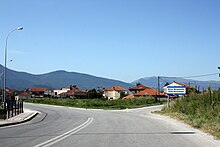Kato Nevrokopi
Kato Nevrokopi Κάτω Νευροκόπι | |
|---|---|
 Kato Nevrokopi center | |
| Coordinates: 41°21′N 23°52′E / 41.350°N 23.867°E | |
| Country | Greece |
| Administrative region | East Macedonia and Thrace |
| Regional unit | Drama |
| Area | |
| • Municipality | 873.6 km2 (337.3 sq mi) |
| Population (2021)[1] | |
| • Municipality | 5,323 |
| • Density | 6.1/km2 (16/sq mi) |
| • Community | 1,855 |
| Time zone | UTC+2 (EET) |
| • Summer (DST) | UTC+3 (EEST) |
| Vehicle registration | ΡΜ |

Kato Nevrokopi (Greek: Κάτω Νευροκόπι, romanized: Káto Nevrokópi "Lower Nevrokopi") is a municipality and town within that municipality in the northwest section of the Drama regional unit, Greece. Before the 2011 local government reform, it was the largest municipality in all of Greece, covering an area of 873.552 km2 (337.28 sq mi).[2] The 2021 census reported a population of 5,323 inhabitants.[1] The region is known for the very low temperatures during the winter and for its famous agricultural products such as potatoes and beans. The area has several features to attract tourists: the ski center of Falakro, the traditional settlement in the village of Granitis (pop. 55), the historical bunker of Lise, the artificial lakes of Lefkogeia and Potamoí, the spectacular routes in the forests, the old churches. The forest paths offer excellent views to hikers. The largest towns are Kato Nevrokopi (the municipal seat, pop. 1,855), Volakas (783), Perithorio (569), Lefkogeia (321), Ochyro (314), Kato Vrontou (287) and Vathytopos (255).[1] On the territory of the municipality are located several abandoned villages, including Monastiri and Mavrochori.
History
[edit]Under the Ottoman Empire, the village was predominantly settled by Bulgarians, with small numbers of Turks and Vlachs. Following the Asia Minor Catastrophe and the subsequent population exchange, it was settled by large numbers of Greek refugees from Asia Minor. In 1927, its name was changed from Ζύρνοβο (Zyrnovo, Зърново) to Kato Nevrokopi,[3] after the neighbouring town of Nevrokop (present Gotse Delchev) in Bulgaria. On 18 April 1945, during fighting related to the Greek civil war, many Slavic Macedonian inhabitants left the area. Many of them resettled in Štip, North Macedonia.
Climate
[edit]Kato Nevrokopi has a humid continental climate. It is one of very few locations in Greece with this climate and is one of the coldest places in the country. It has cold and somewhat snowy winters and warm to hot somewhat humid summers. Precipitation tends to be balanced throughout the year, although there is a small Mediterranean climate influence resulting in July and August being, to a small degree, drier than the rest of the year. Temperatures of -20°C or below have been recorded numerous times in the past. However, there has been a warming trend in the last few years and such temperatures occur less often. Downpours and hail happen sometimes in form of showers in spring and summer. Blizzards and thick fogs in the wintertime have been reported occasionally.
| Climate data for Kato Nevrokopi (2010-2019) | |||||||||||||
|---|---|---|---|---|---|---|---|---|---|---|---|---|---|
| Month | Jan | Feb | Mar | Apr | May | Jun | Jul | Aug | Sep | Oct | Nov | Dec | Year |
| Mean daily maximum °C (°F) | 5.2 (41.4) | 9.3 (48.7) | 13.4 (56.1) | 18.5 (65.3) | 22.6 (72.7) | 26.9 (80.4) | 30.3 (86.5) | 31.1 (88.0) | 26.0 (78.8) | 19.2 (66.6) | 13.6 (56.5) | 6.8 (44.2) | 18.58 (65.44) |
| Daily mean °C (°F) | 0.45 (32.81) | 3.9 (39.0) | 7.2 (45.0) | 11.5 (52.7) | 15.7 (60.3) | 19.7 (67.5) | 22.25 (72.05) | 22.5 (72.5) | 18.15 (64.67) | 12.4 (54.3) | 8.05 (46.49) | 1.85 (35.33) | 11.97 (53.55) |
| Mean daily minimum °C (°F) | −4.3 (24.3) | −1.5 (29.3) | 1.0 (33.8) | 4.5 (40.1) | 8.8 (47.8) | 12.5 (54.5) | 14.2 (57.6) | 13.9 (57.0) | 10.3 (50.5) | 5.6 (42.1) | 2.5 (36.5) | −3.1 (26.4) | 5.37 (41.67) |
| Average rainfall mm (inches) | 65 (2.6) | 67 (2.6) | 64 (2.5) | 39 (1.5) | 68 (2.7) | 59 (2.3) | 39 (1.5) | 37 (1.5) | 46 (1.8) | 47 (1.9) | 73 (2.9) | 61 (2.4) | 665 (26.2) |
| Source: National Observatory of Athens[4] | |||||||||||||
Notable people
[edit]References
[edit]- ^ a b c "Αποτελέσματα Απογραφής Πληθυσμού - Κατοικιών 2021, Μόνιμος Πληθυσμός κατά οικισμό" [Results of the 2021 Population - Housing Census, Permanent population by settlement] (in Greek). Hellenic Statistical Authority. 29 March 2024.
- ^ "Population & housing census 2001 (incl. area and average elevation)" (PDF) (in Greek). National Statistical Service of Greece. Archived from the original (PDF) on 2015-09-21.
- ^ Name changes of settlements in Greece
- ^ "Climate" (in Greek). National Observatory of Athens. Retrieved 13 Aug 2022.
External links
[edit]- Official website (in Greek)


 French
French Deutsch
Deutsch


